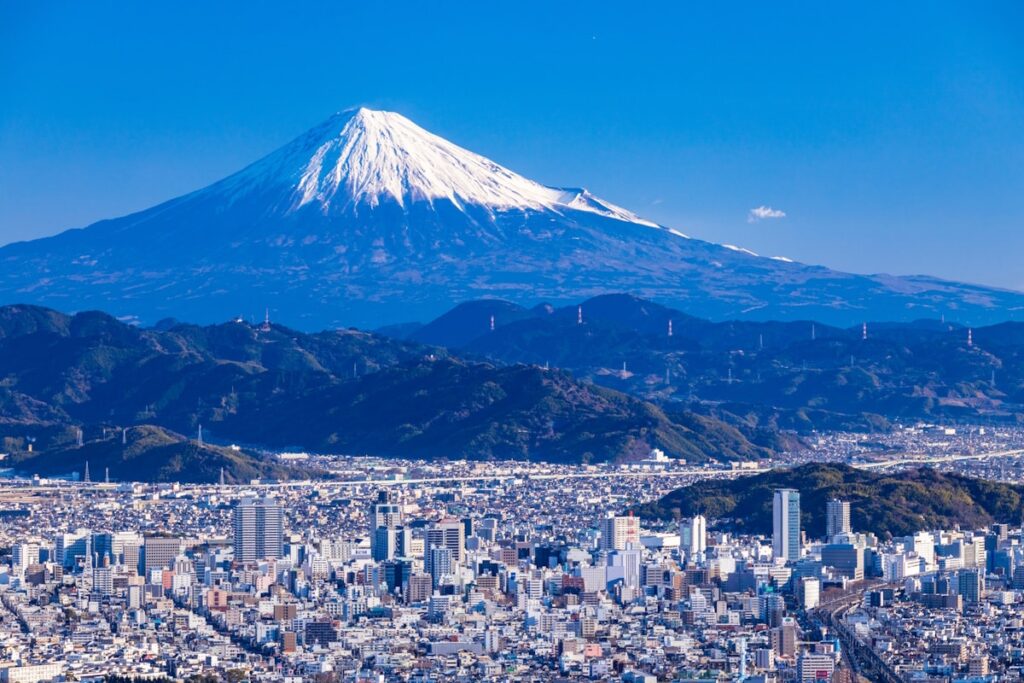[ad_1]
Both overcrowding and so-called “bullet climbing” made headlines this past season at Mt. Fuji. That’s leading Shizuoka Prefecture to rethink whether it should impose a toll system similar to Yamanashi Prefetcure’s starting in July. But that’s easier said than done, as Shizuoka technically doesn’t own the trailheads it wants to toll.
2nd prefecture to combat Mt. Fuji overtourism

Mt. Fuji soars above the two prefectures Yamanashi and Shizuoka. Both sides are introducing new measures to deter bullet climbers who attempt an all-nighter to the top and prevent overcrowding.
In March, Yamanashi announced a plan to charge climbers a ¥2,000 toll (about $13) at trailheads starting July 1st. Shizuoka has stalled talks about a climbing fee but will roll out a web registry system to track climbers’ cabin bookings by June.
“The idea is to have climbers register from their smartphones in advance, input their climbing information which we’ll check. We’re also thinking of a system in which climbers input their mountain cabin details so that we can give the OK at trailheads to those who have cleared all criteria,” Masayuki Ōishi, head of the Mt. Fuji World Heritage Division at Shizuoka’s Tourism Department.
Why Shizuoka won’t charge you (for now)

Shizuoka has three trailheads – Fujinomiya, Gotenba, and Subashiri. Shizuoka Prefecture is hesitant to impose toll systems at these locations because they technically do not own them.
“There are two major problems when it comes to regulations and collecting toll fees in Shizuoka. Below the 8th station on Yamanashi’s side is prefectural territory whereas on Shizuoka’s side, it isn’t,” Ōishi says.
The three trailheads are under the management of the government’s Forestry Agency until the 8th station. From thereon upwards, the Fujisan Hongū Sengen-Taisha Shrine (富士山本宮浅間大社) is the private owner of all land until the summit.
Advertisements
Ōishi has cited the private ownership of Mt. Fuji’s higher levels as an excuse to shut down officials who have suggested working with the shrine to regulate mountain climbers.
“[Shizuoka] should be cooperating with the Fujisan Hongū Sengen-Taisha Shrine in Fujinomiya City, as well as the affiliated shrines,” Katsurō Sakurai, Prefectural Assembly Member said at a recent Culture and Tourism Committee meeting.
Shizuoka Governor Heita Kawakatsu has not called for cooperation with the Sengen Shrine institution.
“It is obligatory to impose climbing fees on Mt. Fuji. It’s a national park, so the obligation to protect its natural environment falls on citizens. Also, because it has become a World Heritage, conservation is an international commitment. Although we must adjust to Yamanashi’s wishes, we have to come out with a plan to make fees obligatory,” Kawakatsu said at a press conference on August 23rd last year.
Who owns Mt. Fuji?
In 1609, the Tokugawa shogunate, Japan’s longest-ruling samurai family, became the owners of Mt. Fuji. The Sengen Shrine had owned it before then.
In 1779, the Tokugawa returned Mt. Fuji from the 8th station upwards to the Sengen Shrine after recognizing this territory as inextricable from religion. This made it necessary for mountain cabin owners to seek permission from the Sengen Shrine to live there.
In the following Meiji period, the government’s unification of the political and religious spheres resulted in the complete de-privatization of Mt. Fuji. As a result, the Sengen Shrine lost ownership yet again.
After WW2, Japan adopted the principle of separation of church and state and returned all sacred mountains to religious institutions, except Mt. Fuji. In 1948, the Sengen Shrine demanded its return, which Yamanashi citizens protested. Tensions rose to a boiling point and the Sengen Shrine filed a lawsuit against the state.
In 1962, the Nagoya District Court ruled in favor of the Sengen Shrine, citing the Tokugawa Shogunate’s handling. The Supreme Court rejected the state’s appeal and recognized Sengen Shrine’s right to Mt. Fuji from the 8th station and upward. The Shrine still owns it today.
Sources
富士山の弾丸登山や登山者のマナー違反対策として「ウエブ登録システム」の導入を検討 富士山適正利用推進協議会. 静岡朝日テレビ
富士山“入山料”2,000円「ちょうど良い」が6割…山梨は義務化も、静岡は「検討中」のワケ. SBS Life
同じ知事でもここまで違うのか…「富士山2000円徴収」を決めた山梨・長崎知事と口先だけの静岡・川勝知事」. PRESIDENT Online
[ad_2]
Source link




